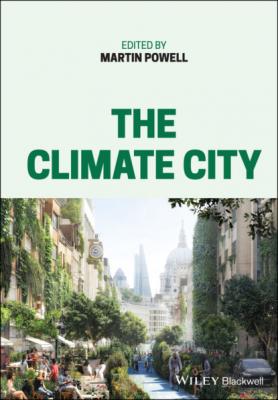The Climate City. Группа авторов
Читать онлайн.| Название | The Climate City |
|---|---|
| Автор произведения | Группа авторов |
| Жанр | Техническая литература |
| Серия | |
| Издательство | Техническая литература |
| Год выпуска | 0 |
| isbn | 9781119746317 |
Figure 1.9 Waters Center’s iceberg model. (Source: Adapted from Aki Fukutani (2015), Iceberg..Seeing What’s Below the surface. Retrieved from: https://yourlearningresource.wordpress.com/2015/02/12/iceberg-model/.)
For the ambitious climate leader in the city, architecting a transition to “Net-Zero” would benefit tremendously from a completed “iceberg” diagram, as shown in Figure 1.9 from the Waters Center for Systems Thinking.31
The fourth dimension of systems thinking talent useful for leaders of the ambitious city is connected to action: the ability to analyse and pull the levers to change the system in ways that further the goal of addressing climate change while also increasing equity and social cohesion. Jay Forester defined leverage points “where a small shift in one thing can produce big changes in everything” and are often counterintuitive. Donella Meadows is arguably the definitive source on defining the levers of system change, and the league table reproduced here is drawn from her book:32
Places to Intervene (in increasing order of effectiveness):
1 12. Constants, Parameters, Numbers (subsidies, taxes, standards)
2 11. Sizes of buffers and other stabilizing stocks, relative to their flows
3 10. Structure of material stocks and flows
4 9. Lengths of delays, relative to the rate of system change
5 8. Strength of negative feedback loops relative to the impacts they are trying to balance
6 7. Gain from driving positive feedback loops
7 6. Structure of Information flows
8 5. The rules of the system (incentives, punishments, constraints)
9 4. The power to add, change, evolve, or self-organize system structure
10 3. The goals of the system
11 2. The mindset or paradigm out of which the system (its goals, structure, rules, culture) arises
12 1. The power to transcend paradigms
Interestingly, much better researched and most-often tried are the shallower, less-effective methods, while the more-effective levers are less researched and less obvious. The applicability of “lever-pulling” to managing a city to address climate change is energizing, and would support efforts to increase listening, communication, and genuine understanding as deep paradigm-shifting system change efforts, and not just a box-ticking exercise on the way to “Net-Zero”. “Net-Zero” is likely not to remain elusive unless these “deep” efforts to change beliefs and social structures are part of the plan.
Conclusion
For the ambitious city to succeed in leading the world on climate action, we have considered how four powerful descriptors could bring new power and clarity to the concept of “Net-Zero” and defined the crucial marker we have to pass to get to a regenerative, sustainable world:
Fully Scoped, Science-Based, Paris-Agreement-Compliant, Cumulative “Net-Zero”.
We then considered how the ambitious city benefits from connected leadership that appreciates, embraces, and is trained in complex systems, creating:
Consequence-curious, Wide-perspective-taking, Depth-finding, Lever-pulling systems thinkers.
As Martin has challenged us all in his Introduction, “How we as leading cities solve the climate crisis will inevitably lie in solving these problems at scale and at a pace that is more aggressive than the national governments the cities reside within”. The city has always been a magnet to ambition. Imagine your city pointing to a clear goal of “Net-Zero” by 2040; led by purpose-driven, connected leaders; aware of, embracing, and trained in the complex system thinking required to accelerate the just transition.
Notes
1 1 UN DESA: 2018 Revision of World Urbanization Prospects. https://www.un.org/development/desa/en/news/population/2018-revision-of-world-urbanization-prospects.html.
2 2 UN estimates > 60% of GHGs and consuming 78% of global energy; C40 estimates > 70% of GHGs, consuming two-thirds of global energy. https://www.un.org/en/climatechange/climate-solutions/cities-pollution. https://www.c40.org.
3 3 Boyd, P., Pickett, C.R., 2020. Defining Net-Zero: Addressing climate change requires a clear, bold explanation of our shared global goal. Yale Center for Business and the Environment. https://cbey.yale.edu/research/defining-net-zero.
4 4 Global Protocol for Community-Scale Greenhouse Gas Emission Inventories. https://ghgprotocol.org/sites/default/files/standards_supporting/gpc_executive_summary_1.pdf.
5 5 By “destination-based” we mean to distinguish an absolute target from a relative one. Many climate targets are relative, for example, “80% less emissions than our 1990 baseline”. Relative targets do not tell a reader if their achievement is consistent with a world in carbon balance. Destination-based targets do.
6 6 Science-based targets have historically focused on corporate action, but the Science-Based Targets Network has more recently started to “translate the science that defines the limits of nature … into actionable targets for cities. https://sciencebasedtargetsnetwork.org/earth-systems.
7 7 Our Common Future. https://sustainabledevelopment.un.org/content/documents/5987our-common-future.pdf. In Commissioner Brundtland’s own foreword: “the ‘environment’ is where we all live; and ‘development’ is what we all do in attempting to improve our lot within that abode. The two are inseparable”.
8 8 In the lead-up to the next global climate talks in Glasgow, the UN champions of the “Race To Zero” campaign are calling for net-zero targets “in the 2040s”.
9 9 UNFCCC, 2015. Paris Agreement. 3–4. https://unfccc.int/sites/default/files/english_paris_agreement.pdf (accessed 3 June 2020).
10 10 Rogelj, J., Luderer, G., Pietzcker, R., et al., 2015. Energy system transformations for limiting end-of-century warming to below 1.5°C. Nature Climate Change 5, 519–527. https://www.nature.com/articles/nclimate2572.
11 11 Masson-Delmotte, V., Zhai, P., Pörtner, H.O., et al. (eds), 2018. Global warming of 1.5°C. An IPCC Special Report on the impacts of global warming of 1.5°C above pre-industrial levels and related global greenhouse gas emission pathways, in the context of strengthening the global response
